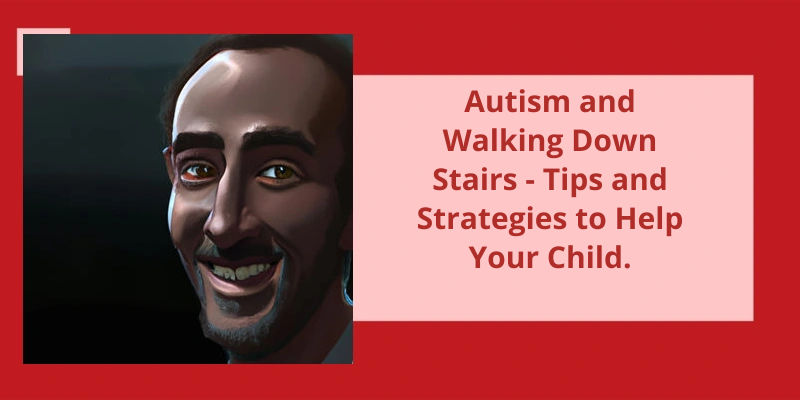Autism is a neurological condition that affects individuals in different ways, causing a range of difficulties with social interaction, communication, and repetitive behaviors. One particular challenge that many individuals with autism face is the ability to walk down stairs. This seemingly simple task can prove difficult for those with autism due to issues with motor coordination, sensory processing, and spatial awareness. As a result, navigating stairs can be a daunting and overwhelming experience, causing anxiety and avoidance behaviors.
What Is the Autistic Way of Walking?
Additionally, researchers have observed that individuals with autism tend to walk with a more rigid, jerky gait. This may be due to difficulties with motor coordination and balance that are commonly seen in people with autism.
Another aspect of the autistic way of walking is an increased tendency to walk on the toes or the balls of the feet. This behavior, known as toe walking, is more common among children with autism than in typically developing children.
Specifically, they suggest that people with autism may walk differently as a way of self-stimulation or to regulate their own arousal levels.
The Link Between Sensory Processing and the Autistic Way of Walking
This article discusses the possible connection between sensory processing and the unique gait commonly observed in individuals with autism spectrum disorder. It explores different theories and studies on this topic and provides insight into how sensory processing difficulties may affect movement and coordination in individuals with autism.
Understanding developmental delays in children with autism is of utmost importance for parents and caregivers. While delayed onset of independent walking is commonly reported in children with intellectual disabilities, the frequency of such delays in children with autism spectrum disorders varies considerably. This article delves deeper into the connection between autism and delayed motor skills, exploring the possible causes and potential solutions.
Do Autistic Kids Start Walking Late?
There’s no clear consensus on whether or not children with autism spectrum disorders (ASD) begin walking later than their typically developing peers. The studies that have been conducted to investigate this question have yielded mixed results. Some studies have suggested that there may be a small delay in the onset of independent walking among children with ASD, while others have found no significant difference between the two groups.
Unlike other developmental delays that are commonly associated with ASD, such as delayed language development or social skills deficits, delayed walking may simply be a byproduct of other comorbid conditions or individual differences.
Even if walking isn’t a core symptom of the disorder, it can still have a major impact on a childs overall functioning and quality of life. For example, delayed walking may limit a childs ability to explore their environment or participate in physical activities with other children their age.
By identifying and addressing any delays in motor development early on, children with ASD can receive the support and intervention they need to reach their full potential.
Source: Autism Spectrum Disorder, Intellectual Disability, and Delayed …
Watch this video on YouTube:
It’s important to note that not all individuals on the autism spectrum exhibit the same restricted and repetitive behaviors. However, some common characteristics include repetitive body movements and motions with objects. Let’s take a closer look at some of these behaviors and how they may manifest in individuals with autism.
What Body Movements Are Characteristics of Autism?
Resistance to changes in routine or environment (e.g. extreme distress or aggression when a usual routine is disrupted)
Sensory sensitivities (e.g. aversion to certain textures or sounds, seeking out certain sensations like deep pressure)
Lack of eye contact or difficulties with social communication (e.g. difficulty understanding social cues or topics of conversation, talking excessively about their interests without regard for others)
These behavioral patterns can manifest in a range of severity, from mild and manageable to severe and disruptive to daily functioning. It’s important to note that none of these behaviors are inherently positive or negative; they simply reflect an individuals unique way of processing and interacting with their environment.
Many of these behaviors serve a sensory or self-regulatory function for the person with autism. For example, repetitive movements may help them release energy or cope with overstimulation, while rigid routines may provide a sense of predictability and safety in an often-unpredictable world. However, these behaviors can also have negative effects, such as limiting social interactions or interfering with learning and daily activities.
There are many evidence-based therapies and approaches that aim to address these behaviors and enhance communication, socialization, and daily living skills for people with autism. These range from behaviorally-based interventions like Applied Behavior Analysis (ABA) to more holistic approaches like sensory integration therapy and animal-assisted therapy. It’s important to seek out professional guidance in identifying the needs and goals of each individual with autism, and tailoring interventions to their unique strengths and challenges.
While autism is often characterized by a range of repetitive behaviors, each individual with autism is unique in their expression and experience of these behaviors. These behaviors serve various functions, from sensory regulation to communication and socialization, and can be managed and addressed through a variety of evidence-based approaches.
The Impact of Autism on Gross and Fine Motor Skills
- Children with autism can experience difficulties with gross motor skills such as running, jumping, and climbing.
- Fine motor skills, such as writing and buttoning clothes, can also be challenging for children with autism.
- These difficulties may be due to differences in brain function and the way information is processed and organized.
- Early intervention and targeted therapy can help improve motor skills in children with autism.
- Occupational therapy, physical therapy, and sensory integration therapy are all potential treatments for improving motor skills in children with autism.
In addition to it’s physical benefits, climbing has been found to be a particularly good activity for children with autism. Because it involves independent movement and minimal physical contact, it can be especially appealing to those who may be uncomfortable with typical social interactions. And the opportunity for cross-curricular learning, such as practicing letter recognition and spelling on the climbing wall, makes it even more valuable as a therapeutic activity.
Is Climbing Good for Autism?
Climbing has been proven to be a beneficial activity for individuals with autism. It offers them the opportunity to engage in independent movement, allowing them to explore their surrounding environment while developing gross motor skills.
It can help to improve their hand-eye coordination, balance, and overall strength.
In addition to the physical benefits, climbing also offers plenty of opportunities for cross-curricular learning. Climbing walls are often designed with letters and words, which can spark interest in written communication. For example, children can find letters or spell out words as they climb, providing a fun and engaging way to learn essential language and literacy skills.
It offers a unique and engaging way to develop physical, cognitive, and social skills while having fun at the same time. Whether climbing in a group or independently, there are plenty of benefits to be gained from this popular pastime.
Understanding the signs of autism is an essential part of early detection and intervention. Although many of them may be subtle, certain indicators like toe walking, can provide clues to underlying conditions, such as autism spectrum disorder (ASD). While not all children who walk on their toes have autism, the combination of other symptoms such as language delays and cognitive impairments should be carefully evaluated by a medical professional.
What Are the Signs of Autism in Walking?
However, it’s important to note that not all children with autism will walk on their toes. Some may have other unusual walking patterns or difficulties with balance and coordination. It’s also possible for a child to walk normally but still display other signs of autism, such as social difficulties and repetitive behaviors.
Another potential sign of autism in walking is the use of exaggerated arm movements or a lack of arm swing. Children with autism may walk with their arms held stiffly at their sides, or they may swing their arms in an unusual or erratic manner. This can be indicative of difficulties with motor planning and coordination, which are common in autism spectrum disorder.
They may struggle with learning to ride a bike or participate in other physical activities that require coordination and balance. They may also avoid certain types of play, such as running or jumping, and may prefer to engage in more sedentary activities.
Parents and caregivers should also look for other social and behavioral signs of autism, such as difficulties with communication and social interaction, repetitive behaviors, and sensory sensitivities.
If you’ve concerns about your childs development, it’s important to consult with a healthcare professional or developmental pediatrician for an accurate diagnosis and appropriate support and intervention. With early detection and intervention, children with autism can thrive and reach their full potential.
How Autism Affects Gross Motor and Fine Motor Skills
Autism can affect gross and fine motor skills in individuals. Gross motor skills such as coordination and balance can be affected, while fine motor skills such as hand-eye coordination and gripping can also be impacted.
It’s fascinating to see children with Autism Spectrum Disorder (ASD) engaged in various activities that may seem mundane to others. One such activity that stands out among them is climbing stairs. The thrill of dropping a ball and watching it roll down after climbing a staircase is something that many ASD children enjoy. Apart from that, the exhibit also features a windmill that caught the attention of several children. Let’s explore some more interesting facts about ASD and their experiences with different activities.
Do Autistic Kids Climb Stairs?
There’s no straightforward answer to whether or not autistic kids climb stairs. Like any other child, some might love to climb stairs while others might avoid it due to fears or sensory difficulties associated with it. However, there are a few specific activities that have been found to be popular among children with Autism Spectrum Disorder (ASD), and one of them is climbing stairs.
The setup involves a short staircase that the children can climb and then drop a ball from the top, which they can watch descend to the bottom. It’s believed that climbing stairs can provide sensory input and proprioceptive feedback that can be calming for children with ASD. The thrill of watching the ball falling down after climbing up the stairs might also be a source of joy for them.
Apart from climbing stairs, another activity that’s been observed as popular among autistic kids is the windmill. The exhibit involves a small windmill that children can spin using their hands. Like the staircase, spinning the windmill can also provide sensory input and help regulate the childs nervous system. It can also be a source of joy and excitement, which can be particularly beneficial for children who struggle with social interactions and communication.
Some children might be more drawn towards activities that involve repetitive movements, while others might prefer activities that challenge their motor skills. Regardless of the specific activity, it’s important to provide opportunities for children with ASD to engage in activities that promote their physical and emotional wellbeing.
Some children might struggle with sensory processing difficulties that can make certain activities overwhelming or unpleasant. In such cases, it’s important to work closely with professionals such as occupational therapists, who can provide individualized recommendations and strategies to help the child overcome their challenges and engage in activities that are beneficial for them.
As caregivers, educators, and professionals, our role is to listen, observe, and support each child on their journey towards growth and self-discovery.
Conclusion
It’s important to recognize the unique needs and abilities of each individual with autism and to provide them with the necessary accommodations to ensure their safety and quality of life. By increasing awareness and understanding of the challenges faced by those with autism, we can work towards creating a more inclusive and supportive society for all. With research, education, and resources focused on autism, we can continue to make progress towards improving the lives of individuals with autism and their families.






